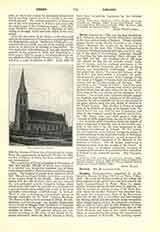

Desains, PAUL-QUENTIN, physicist, b. at St-Quentin, France, July 12, 1817; d. at Paris, May 3, 1885. He made his literary studies at the College des Bons-Enfants in his native town and then entered the Lycee Louis-le-Grand in Paris. Here he distinguished himself, taking the first prize in physics. In 1835 he entered the science section of the Ecole Nor-male where his brother Edouard had preceded him. He made the acquaintance there of La Provostaye who was at the time a surveillant and who became his lifelong friend and his associate in his researches.
After completing his course, he accepted a professor-ship in 1839 at Caen, and in 1841 returned to Paris where he received similar appointments, first at the Lycée St-Louis and later at the Lycee Condorcet, where he succeeded La Provostaye who was forced to retire on account of ill-health. His growing reputation won for him in 1853 the chair of physics at the Sorbonne which he held for thirty-two years. His lectures were characterized by great clearness and precision and many of his experimental illustrations were devised or improved by him.
Between 1858 and 1861 he made many observations in connection with terrestrial magnetism. His most important contributions to physics, however, were his researches on radiant heat made in conjunction with La Provostaye. With rare experimental skill the two physicists proved that radiant heat, like light, is a disturbance set up in the ether and propagated in all directions by transverse waves. They showed in a series of “Memoires” published in the “Annales de Chimie et de Physique” that it manifests the characteristic phenomena of reflection, refraction, and polarization, as well as of emission and absorption. They also made a study of the latent heat of fusion of ice, and a careful investigation of the range of applicability of the formula of Dulong and Petit representing the law of cooling. Of no less importance, however, was Desain’s work in connection with the establishment and development of laboratory instruction in physics. When the “Ecole pratique des hautes etudes” was founded in 1869 he was commissioned to organize the physical laboratory. He made it a model of its kind both in completeness and in convenience of detail. During the siege of Paris in 1870, he succeeded after many difficulties in establishing electrical communication with d’Almeida who was outside the lines. The exposure he underwent brought on a rheumatism which greatly weakened his constitution. Desains published a “Traite de Physique” (Paris, 1855) and numerous articles, chiefly with La Provostaye. Among them are: “Recherches sur la chaleur latente de fusion de la glace” (Ann. de chim. et de phys. [3], VIII, 5); “Notes et memoires sur les lois du rayonnement de la chaleur” (ibid., XII, 129, XVI, 337, XXII, 358); “Memoire sur la polarisation de la chaleur” (ibid, XXVII, 109, 232, XXVIII, 252, XXX, 159); “Memoire sur les anneaux colores” (ibid., XXVII, 423); “Memoire sur la reflexion de la chaleur” (ibid., XXX, 276); “Memoires sur la determination du pouvoir absorbant des corps pour la chaleur rayonnante” (XXX, 431); etc.
H. M. BROOK

